CACTUS |
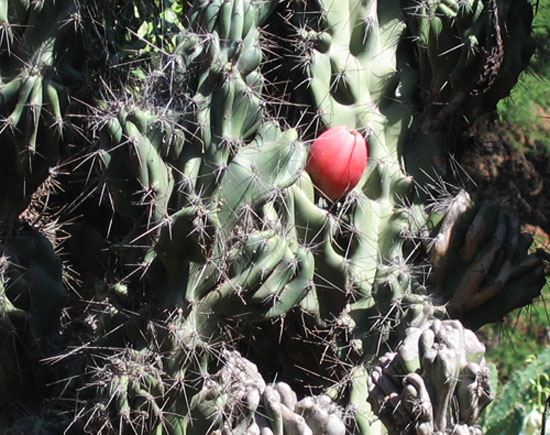 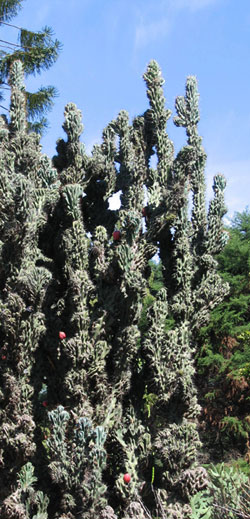 Apple
Cactus, Column Cactus, Peruvian Apple Cereus peruvianus,
C. hildmannianus, C. uruguayanus, C. peruvianus monstrosa Apple
Cactus, Column Cactus, Peruvian Apple Cereus peruvianus,
C. hildmannianus, C. uruguayanus, C. peruvianus monstrosa
This cactus is wonderful and would make an idea center plant in the garden. I
think it would look best with a bit of room so it can really show off. It will
grow to be at least 12 feet tall as it is in the photograph below on the right.
Benefits:
From: Middle South America
Photographed: In the Carlos Thays Botanical Garden
in Buenos Aires, Argentina.
Planting and Care:
Text and Photographs ©GreenGardeningCookingCuring.com
2011 |
| |
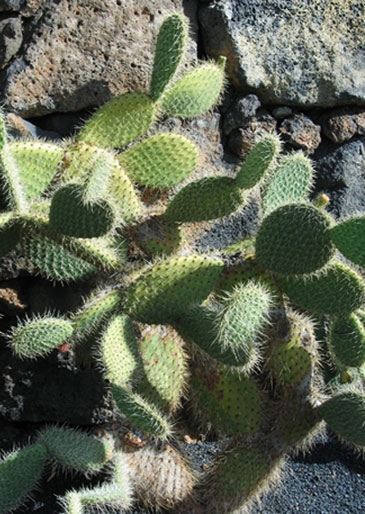 Arborescent
Prickly Pear, Aaron's Beard Cactus, Semaphore Cactus Opuntia
leucotricha Arborescent
Prickly Pear, Aaron's Beard Cactus, Semaphore Cactus Opuntia
leucotricha
Benefits:
From: Mexico
Photographed: At
the Jardin de Cactus in Lanzarote, Canary Islands, Spain, in 2014.
Planting and Care:
Text and Photograph ©GreenGardeningCookingCuring.com
2014/2019 |
| |
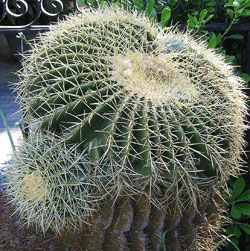 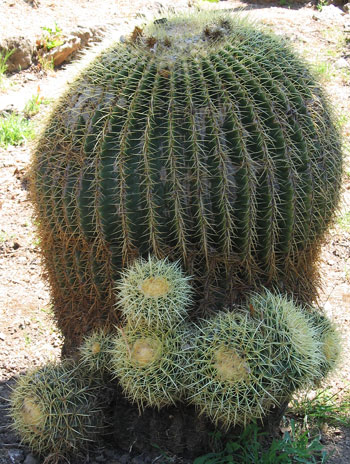 Barrel
Cactus, Golden Barrel Cactus, Golden Ball, Mother-in-Law's-Cushion Echinocactus
grusonii Hildm. Barrel
Cactus, Golden Barrel Cactus, Golden Ball, Mother-in-Law's-Cushion Echinocactus
grusonii Hildm.
Sadly this beautiful cactus is critically endangered in the wild. Its beauty
will save it in gardens and planters, but it seems a shame that it is relegated
to having only such a life.
Benefits:
From: Central Mexico
Photographed: In the Palermo Botanical Garden in Sicily, Italy,
2012, unless otherwise noted.
Planting and Care: The barrel cactus will grow to be about
a yard wide and tall, but only after many years. Imagine it won't even
flower until it is 20 years old. To be happy give it a dry winter with
no frost, full sun and light watering.
Text and Photographs ©GreenGardeningCookingCuring.com
2012/2019 |
| |
Photographed: At
the Jardin de Cactus in Lanzarote, Canary Islands, Spain, in
2014.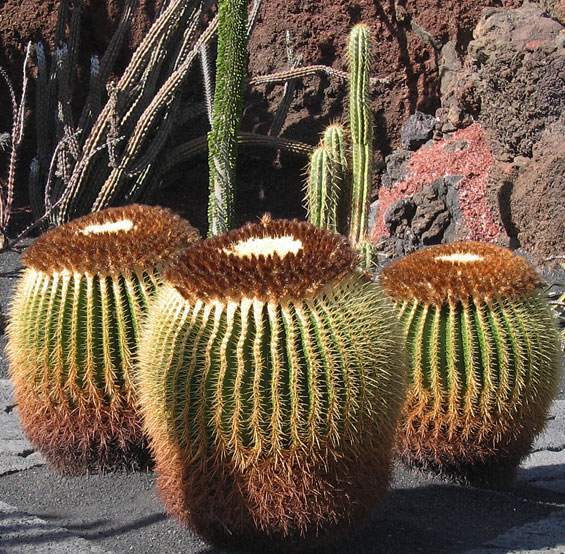
|
|
| |
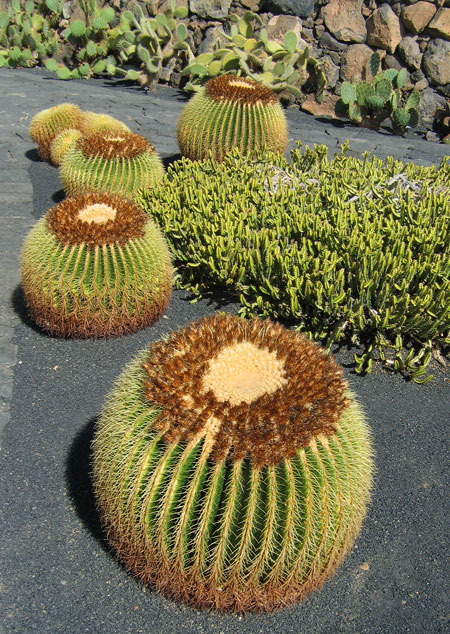 Photographed: At
the Jardin de Cactus in Lanzarote, Canary Islands, Spain, in 2014. Photographed: At
the Jardin de Cactus in Lanzarote, Canary Islands, Spain, in 2014. |
| |
Photographed: In
the Royal Botanic Garden in Sydney, Australia, in 2013.
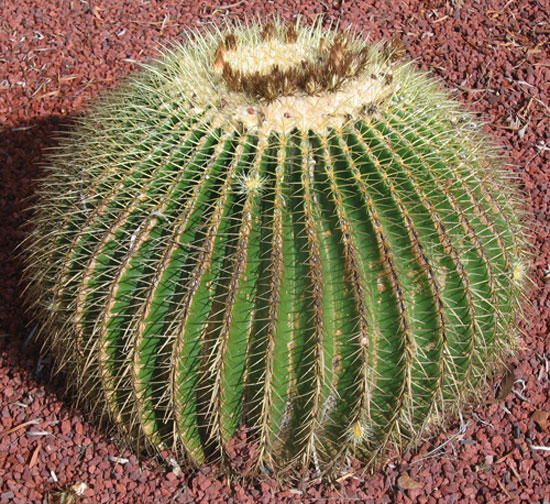
|
| |
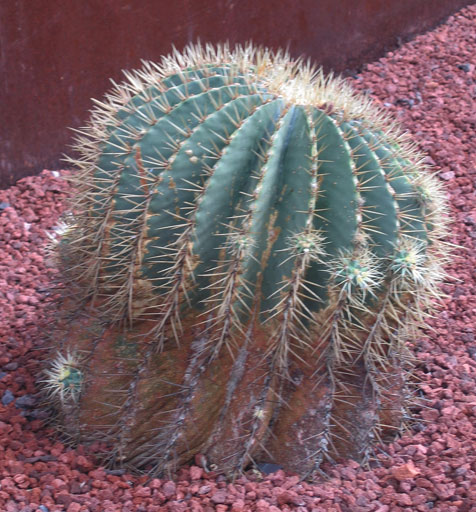 Blue
Barrel Cactus Blue
Barrel Cactus
Benefits:
From:
Photographed: In the Royal Botanical Gardens in Sydney,
Australia, 2013.
Planting and Care:
Text and Photograph ©GreenGardeningCookingCuring.com
2013 |
| |
Bishop's
Cap Cactus, Bishop's Hat or Bishop's Miter Cactus Astrophytum
myriostigma
With a little luck this beauty will grow to be as much as 8" wide and
40" tall. Because of its appearance is it a favorite in cactus collections.
It does flower, but I wouldn't be holding my breath.
Benefits:
From: Northeastern and central mountainous areas of Mexico
Photographed: Below on the left in the Botanical Garden in
Naples, Italy, and on the right in the Carlos Thays Botanical Garden in Buenos
Planting
and Care: It
comes from hot dry areas of Mexico where there is a rainy season only in the
summer months. Hence be careful of over watering
and keep it in the sun and as warm as possible.
Text and Photograph ©GreenGardeningCookingCuring.com
2015
With
my gratitude, my cactus mystery #2 was identified by Richard
L., a visitor to the site. |
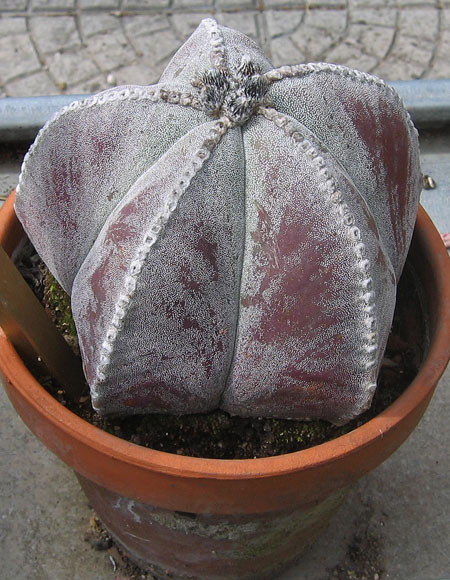 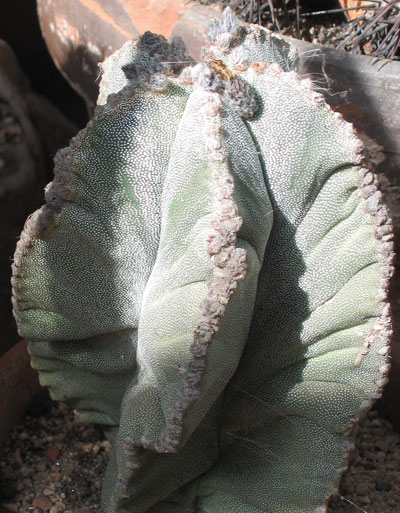
|
| |
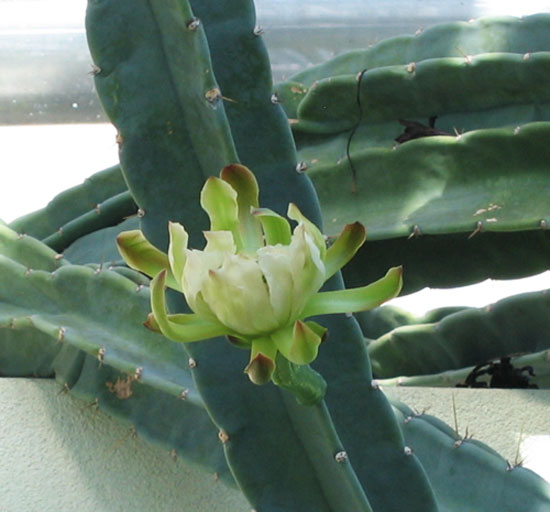 Blue
Candle, Whortleberry Cactus Myrtillocactus
geometrizans Blue
Candle, Whortleberry Cactus Myrtillocactus
geometrizans
Benefits:
From:
Photographed: At the Roger Williams Park Botanical Center in Rhode Island
in 2014.
Planting and Care:
Text and Photograph ©GreenGardeningCookingCuring.com
2018 |
| |
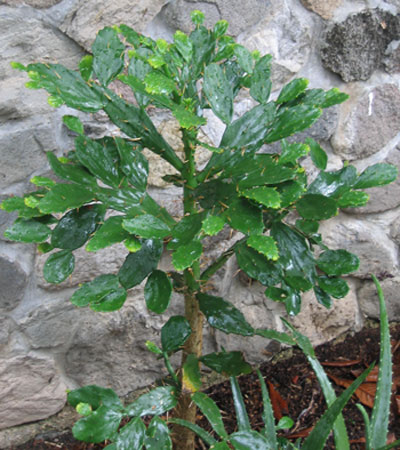 **Brazilian
Pricklypear Brasiliopuntia Brasiliensis -Cuija **Brazilian
Pricklypear Brasiliopuntia Brasiliensis -Cuija
In my experience this is a relatively fast growing and easy to care for cactus.
It seems to be very healthy and to roll with both dry and rainy seasons without
noticeably acting up. It is a lovely plant.
Benefits:
From: Brazil, Uruguay, Argentina, Bolivia and Peru
Photographed: In my garden at Lake Atitlan in Guatemala in
2013.
Planting and Care: I have mine
growing in a semi shady area and it seems to be doing just fine. I
highly doubt that it would be frost hardy.
Text and Photographs ©GreenGardeningCookingCuring.com
2014
Former
mysteries 120 and 120a were solved by Samantha B. in Georgia. |
Brazilian
Pricklypear in Bloom
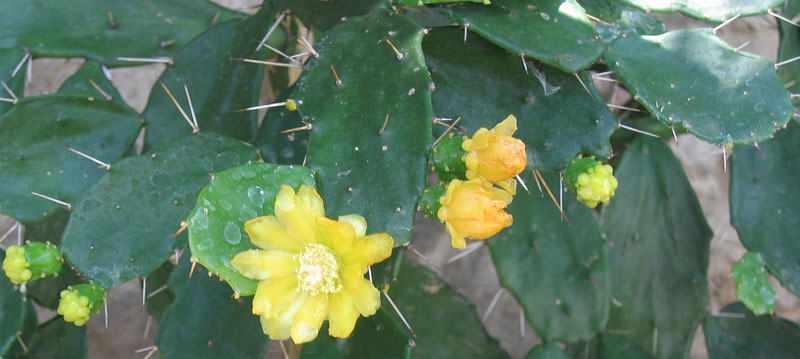
|
| |
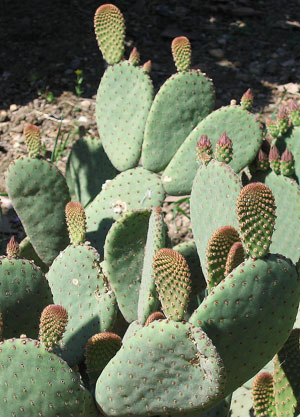 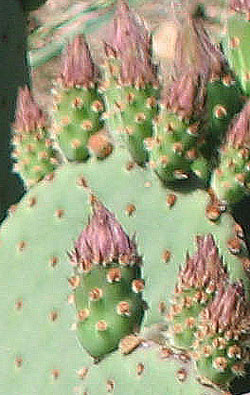 Bunny
Ears, Polka Dot Cactus Opuntia microdasys (Lehmann) Bunny
Ears, Polka Dot Cactus Opuntia microdasys (Lehmann)
This is a large very appealing cactus that will grow to be 12 feet tall if it's
happy and end up being about 5 feet across.
Benefits:
From: Mexico
Photographed: In the Palermo Botanical Garden in Sicily, Italy.
Planting and Care: Bunny ears will grow in full sun or bright
partial shade in well drained soil that is moistened only when completely dry.
They
will handle temperatures to 40 degrees F., but best not to test their resolve.
Text and Photographs ©GreenGardeningCookingCuring.com
2012 |
| |
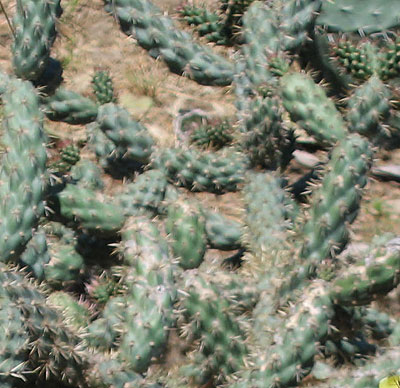 Cane
Cactus, Coral Cactus Austrocylindropuntia cylindrica
(Lam.) Cane
Cactus, Coral Cactus Austrocylindropuntia cylindrica
(Lam.)
Benefits:
From: Ecuador and Peru
Photographed: In the Botanical Garden in Palermo, Sicily, in
Italy in 2012.
Planting and Care:
Text and Photograph ©GreenGardeningCookingCuring.com
2014 |
| |
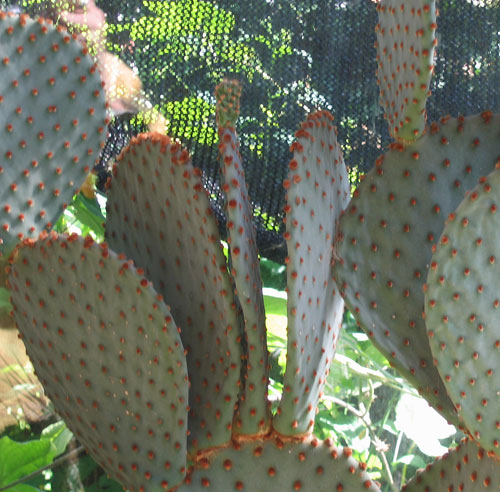 Cinnamon
Cactus, Bunny Ears Cactus, Bunny Cactus, Polka-dot Cactus Opuntia
microdasys var. rufida and many many synonyms Cinnamon
Cactus, Bunny Ears Cactus, Bunny Cactus, Polka-dot Cactus Opuntia
microdasys var. rufida and many many synonyms
Benefits:
From: Northern areas of Mexico or Texas
Photographed: In the Carlos Thays Botanical
Garden in Buenos Aires, Argentina.
Planting and Care:
Text and Photograph ©GreenGardeningCookingCuring.com
2014 |
| |
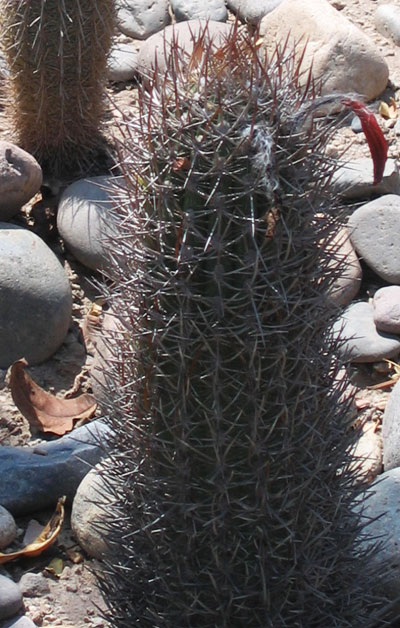 Cleistocactus
xylorhizus No common name yet Cleistocactus
xylorhizus No common name yet
Benefits:
From: Peru
Photographed: In
Parque de la Leyendas, Lima, Peru, in 2013.
Planting and Care:
Text and Photograph ©GreenGardeningCookingCuring.com
2014 |
| |
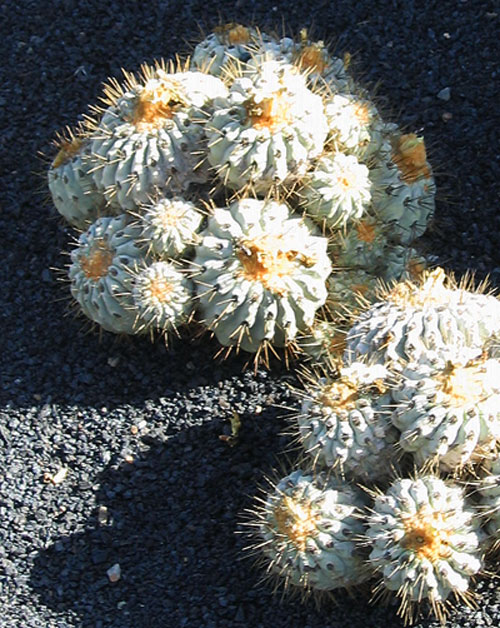 Copiapoa-cinerea-purpurea No
Common Name Yet Copiapoa-cinerea-purpurea No
Common Name Yet
This is a slow growing cactus that will in good conditions reach a size of about
3 feet tall.
Benefits:
From: Northern Chile
Photographed: At
the Jardin de Cactus in Lanzarote, Canary Islands, Spain, in 2014.
Planting
and Care: This beauty grows in an area of northern Chile which
is especially dry though it does receive morning and evening thick ocean
fog. In summer, water when dry and plant it in an area of the garden
that does not get hot afternoon sun. In its native environment, its light
gray color provides it with some protection from hot sun.
Text and Photograph ©GreenGardeningCookingCuring.com
2014 |
| |
| Coral
Cactus |
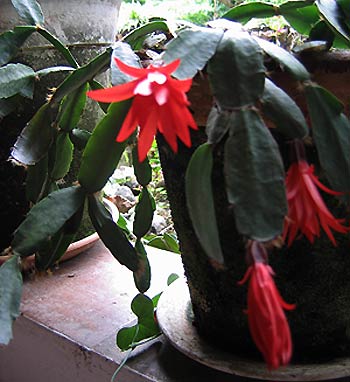 Easter
Cactus, Spring Cactus, Whitsun Cactus Schlumbergera
gaertneri and syn. Hatiora gaertneri Easter
Cactus, Spring Cactus, Whitsun Cactus Schlumbergera
gaertneri and syn. Hatiora gaertneri
More often than not these pretty bloomers
are sold in hanging pots where their stems and
flowers are shown at their best.
Benefits:
From: Brazil
Photographed: In the Botanical Garden at the Hotel Atitlan
on Lake Atitlan in Guatemala.
Planting and Care: In nature these are epiphytic
plants. Reproducing those conditions will net you the happiest
plant -- semi shade and evenly moist organically rich slightly
acidic soil and, if grown indoors, it will love a daily light
spritzing of water. Luckily they are pretty flexible so they
will look good without having the perfect situation.
Text & Photograph ©KO 2010, ©GreenGardeningCookingCuring.com
2018 |
| |
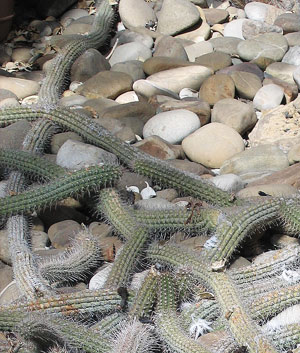 Easter
Lily Cactus, Sea Urchin Cactus Trichocereus thelagonus Easter
Lily Cactus, Sea Urchin Cactus Trichocereus thelagonus
This is an attractive and very peculiar sort of cactus as it has a penchant for
lying down on the job and its branches can become up to seven feet long. It is
in
the
cereus
family
so
it
also
has
fabulous
night
blooming flowers in the summer.
Benefits:
From: South America
Photographed: In the Palermo Botanical Garden in Sicily, Italy.
Planting and Care: This cactus likes to grow in full sun in
well drained soil. For moisture, it prefers an infrequent drenching. It is tolerant
of a little bit of cold, but it doesn't really like it if it can be avoided.
Text and Photograph ©GreenGardeningCookingCuring.com
2012 |
| |
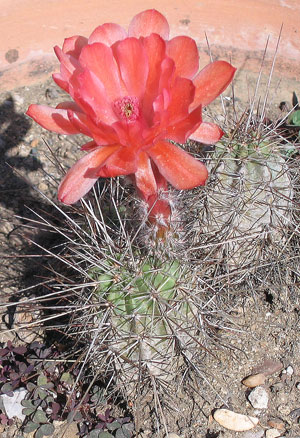 Engelmann's
Hedgehog Cactus, Strawberry Hedgehog Cactus Echinocereus
engelmannii Engelmann's
Hedgehog Cactus, Strawberry Hedgehog Cactus Echinocereus
engelmannii
Benefits: None that I've found so far except
for the beauty of its flower.
From: The southwestern USA and Northern Mexico
Photographed: In the Palermo Botanical Garden in Sicily, Italy.
Planting and Care: This plant grows in full sun on rocky and
sandy slopes in dry desert regions. It has some cold tolerance and prefers a
little more water
than true desert plants.
Text and Photograph ©GreenGardeningCookingCuring.com
2012/2018 |
| |
|
EUPHORBIAS |
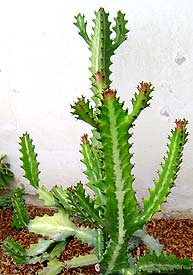 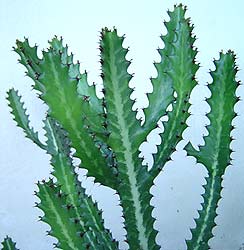 **Candelabra
Cactus Euphorbia candelabrum or Euphorbia lactea **Candelabra
Cactus Euphorbia candelabrum or Euphorbia lactea
Sometimes
growing to as much as 15 feet, the candelabra cactus is a sharply
spined, thick branching variety. Every year the candelabra
cactus beside our front door became home to a banana quit family.
These lovely sweet tiny little birds love the candelabra for
some reason. Maybe it offers them protection from predators.
From:
Photographed: In
its early years in our front border garden at our former home in Montserrat,
unless otherwise noted. Planting
and Care: As cactus go,
the candelabra is relatively fast growing and very easy to care for. Give it
a warm
weather
climate, lots of sun and a moderate amount of water and it will be off and running.
They are very attractive plants and make great centerpieces for a cactus garden.
Text & Photographs ©KO 2004/2010
and ©GreenGardeningCookingCuring.com 2015. |
| |
Photographed: In
the Canary Islands, Spain, in 2014.
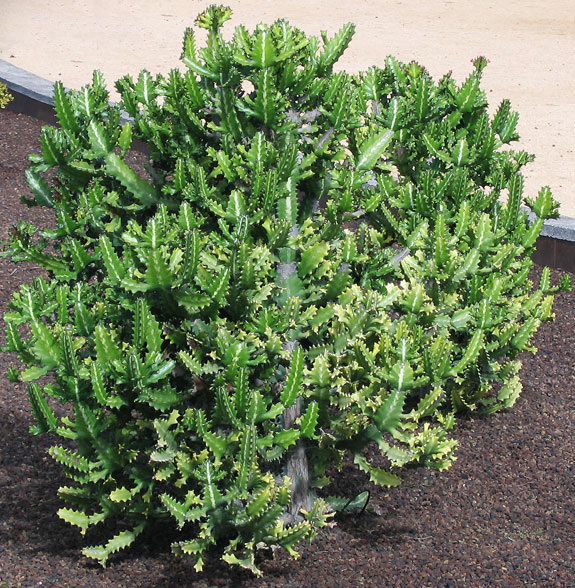
|
Photographed: In
Parque de la Leyendas, Lima, Peru, in 2013.
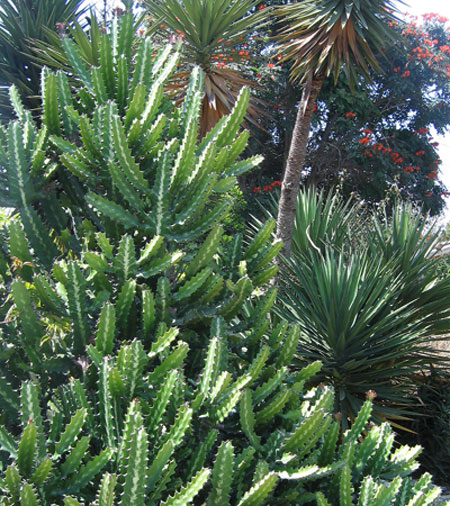
|
|
Photographed
in Crown Point, Tobago, in 2017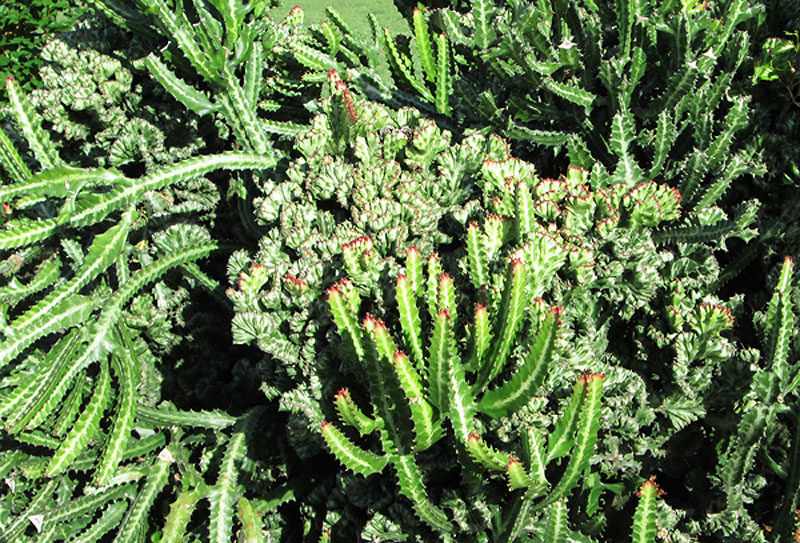 |
| |
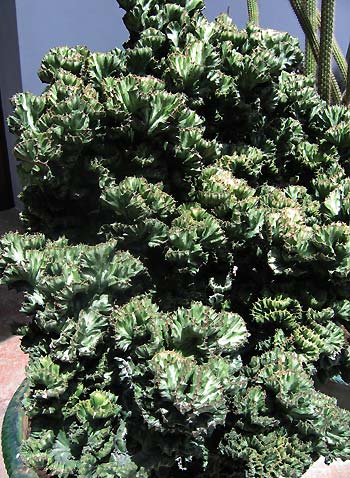 Candelabra
Plant, Elkhorn Euphorbia lactea cristea Candelabra
Plant, Elkhorn Euphorbia lactea cristea
Oddly enough this peculiar looking cactus is a relative of the candelabra cactus
above and it shares many of the same characteristics. It is poisonous and the
white sap that oozes from any wound is said to be especially irritating as well.
I have not found that to be particularly true of the many candelabras we have
growing in our garden in Montserrat.
From: India
Photographed: In the city of Oaxaca, Mexico, 2009.
Planting and Care: Give this family of plants full sun
or as much sun as possible. Water sparingly and they will all do just fine.
Text & Photograph
©KO 2009 |
Euphorbia
avasmontana No Common Name Yet
Benefits:
From: Namibia
Photographed: At
the Jardin de Cactus in Lanzarote, Canary Islands, Spain, in 2014.
Planting
and Care:
Text and Photograph ©GreenGardeningCookingCuring.com
2014 |
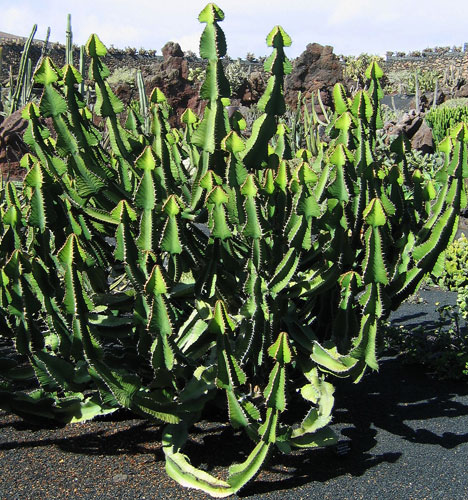 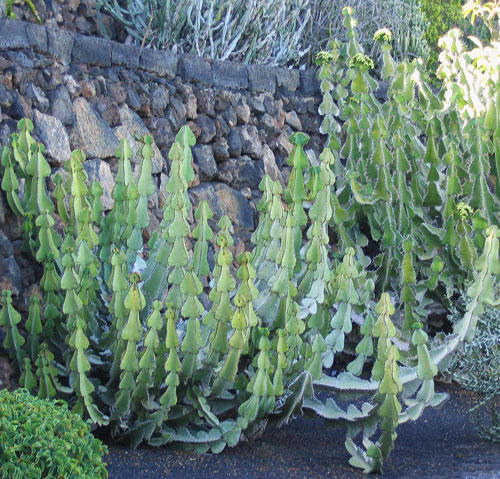 |
| |
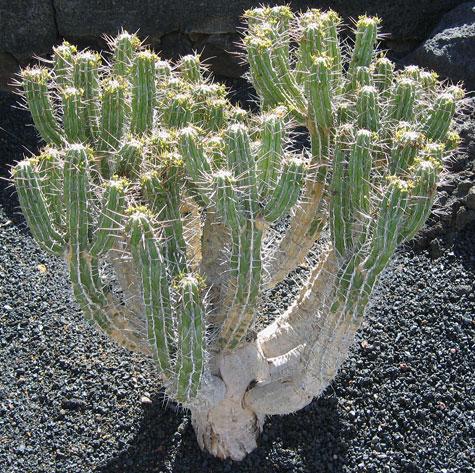 Euphorbia
handiensis No Common Name Yet Euphorbia
handiensis No Common Name Yet
Benefits:
From:
Photographed: At
the Jardin de Cactus in Lanzarote, Canary Islands, Spain, in 2014.
Planting
and Care:
Text and Photograph ©GreenGardeningCookingCuring.com
2014 |
| |
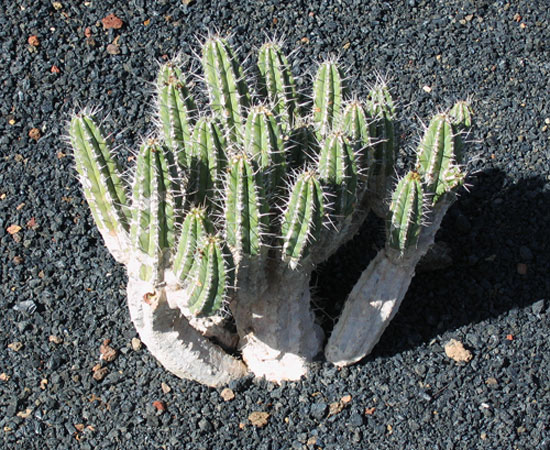 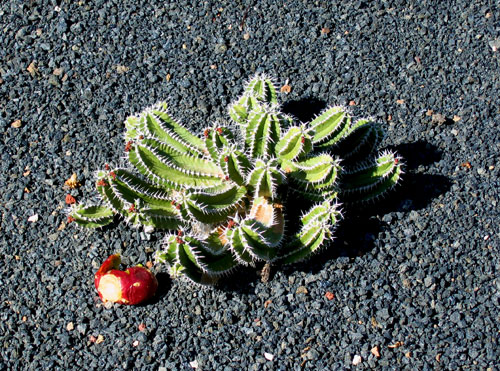 |
| |
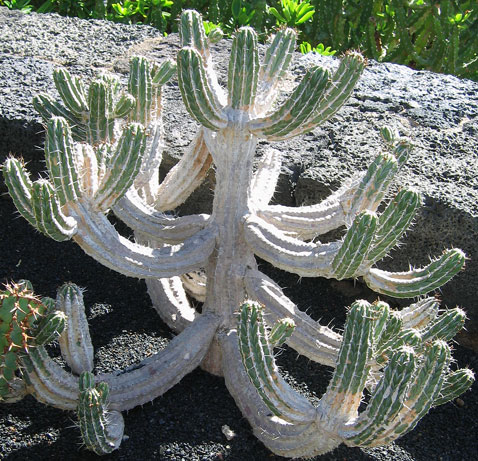 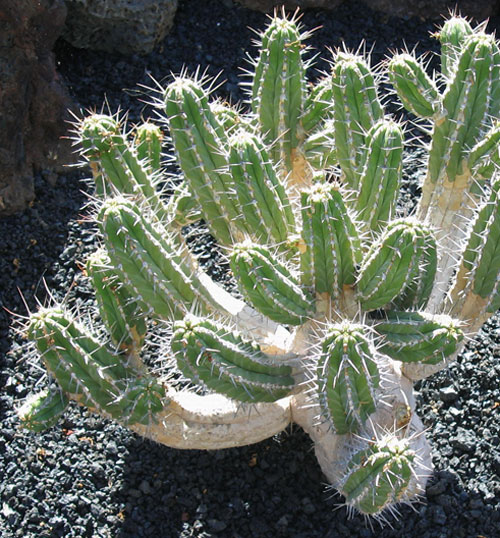 |
| |
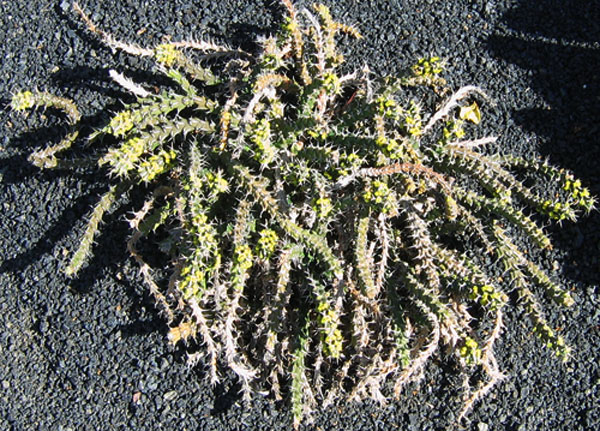 Euphorbia
knuthii No Common Name Yet Euphorbia
knuthii No Common Name Yet
Benefits:
From: Mozambique
Photographed: At
the Jardin de Cactus in Lanzarote, Canary Islands, Spain, in 2014.
Planting and Care:
Text and Photograph ©GreenGardeningCookingCuring.com
2014 |
| |
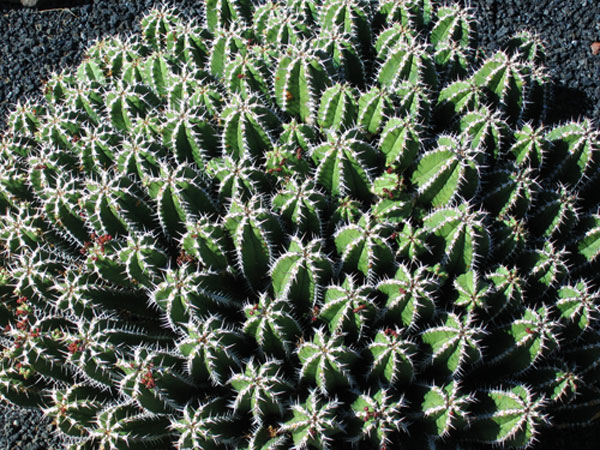 Euphorbia-polycantha
NO COMMON NAME YET Euphorbia-polycantha
NO COMMON NAME YET
Benefits:
From:
Photographed:
Planting and Care:
Text and Photograph ©GreenGardeningCookingCuring.com
2018
|
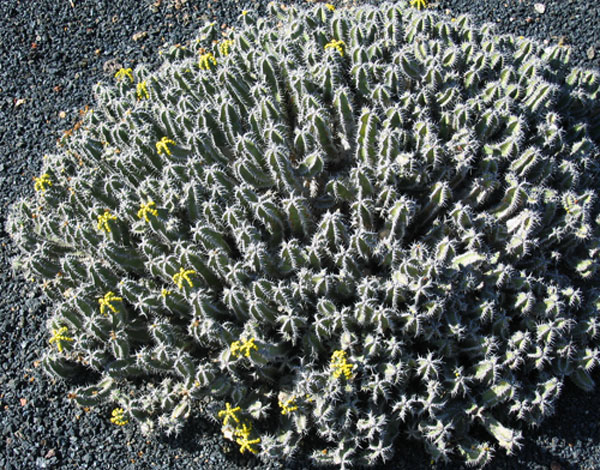 Euphorbia-polycantha Euphorbia-polycantha
Benefits:
From:
Photographed:
Planting and Care:
Text and Photograph ©GreenGardeningCookingCuring.com
2018 |
| |
|
| |
Fishbone
Cactus, Moon Cactus, Zigzag Cactus, Queen of the Night, Rickrack
Cactus, Rick-Rack Orchid Cactus Epiphyllum anguliger
I bought this plant at the market at Lake Atitlan in Guatemala. It came home
with me in its coke bottle pot and lived in my still fragile cactus garden. I
didn't know until now that it is normally terrestrial, but it seemed okay on
the ground. Its blossoms are said to be glorious.
Benefits: Other than its spectacular blooms, I haven't found
any.
From: Mexico
Photographed:
Planting and Care: To be at its best, this plant should be in
a hanging planter or placed securely in a tree where you can still care for it.
Bright shade is probably best and routine watering during growing season won't
hurt either. Cut back on the water during the cool months.
Text ©GreenGardeningCookingCuring.com
2014/2018 |
| |
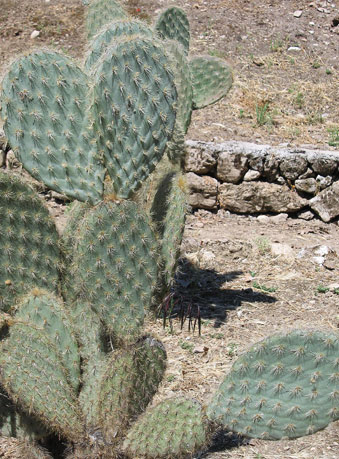 Galapagos
Prickly Pear Opuntia galapageia Galapagos
Prickly Pear Opuntia galapageia
Benefits: This cactus provides food for many
of the unique species of animals that live in the Galapagos Islands.
From: Ecuador's Galapagos Islands
Photographed: In the Palermo Botanical
Garden in Sicily, Italy.
Planting and Care: These cactus largely
grow in arid conditions and may be considered at risk
in the Galapagos due to the large population of feral
goats which have consumed them as food.
Text and Photograph ©GreenGardeningCookingCuring.com
2018 |
| |
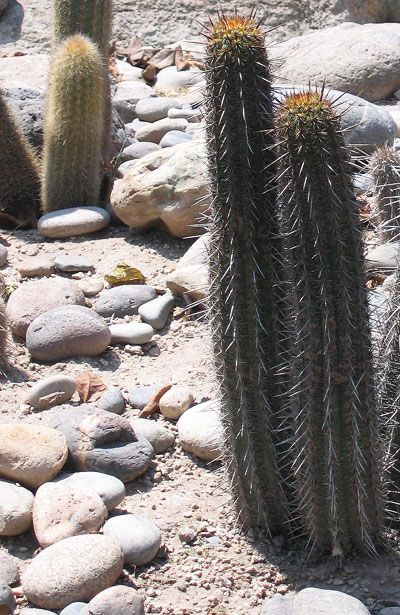 Haageocereus
acranthus No Common Name Yet Haageocereus
acranthus No Common Name Yet
Benefits:
From:
Photographed: In
Parque de la Leyendas, Lima, Peru, in 2013.
Planting and Care:
Text and Photograph ©GreenGardeningCookingCuring.com
2014 |
| |
**Leaf
Cactus, Rose Cactus, Wax Rose, Seven Star Needle Pereskia
bleo
This very appealing plant has EXTREMELY
long and piercing spines which makes it difficult
to transplant so try to pick the idea spot for it right away
so you never have to move it.
Benefits: Research is underway to explore its potential in treating
certain cancers.
From: Shady moist forested areas of Central America
Photographed: Growing in a pot by our front door and later while flowering
after being planted in the deck garden at our former home in Montserrat.
Planting and growth: This is a warm weather cactus which
grew beautifully in the Caribbean in a very sunny spot by the entrance and
then in the garden in an area that received morning sun. I found it pretty
adaptable, but it did seem to require a hefty amount of fertilizer to be
at its best. It also likes more water than most other cactus.
Text & Photographs ©Krika.com
2008 and GreenGardeningCookingCuring.com 2013/2018
Mystery
solved by Ursula G. living in Southern Germany |
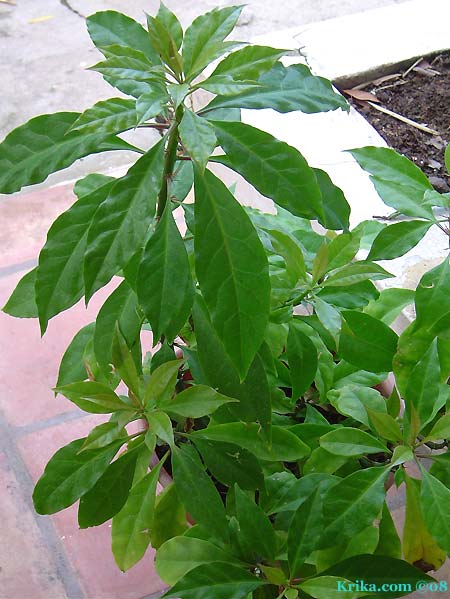 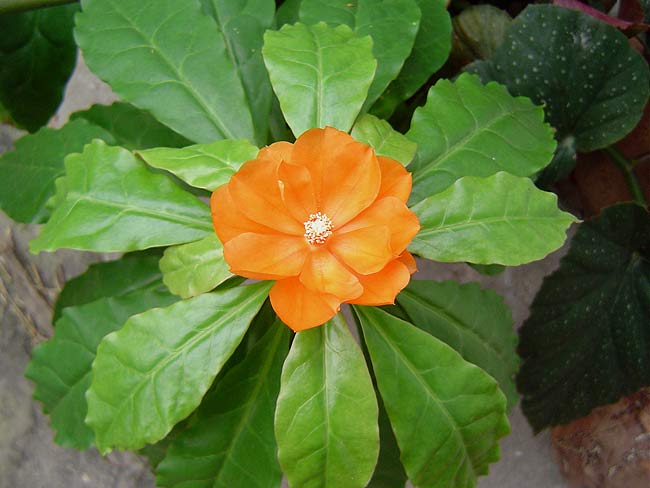 |
| |
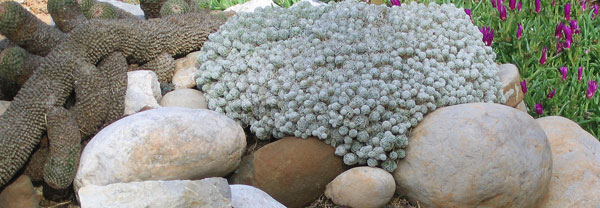 Mammillaria
gracilis No Common Name Yet Mammillaria
gracilis No Common Name Yet
Benefits:
From: Mexico
Photographed: In the (Ortobotanico) Botanical Garden
in Naples, Italy, in 2014.
Planting and Care:
Text and Photograph © GreenGardeningCookingCuring.com
2014
|
| |
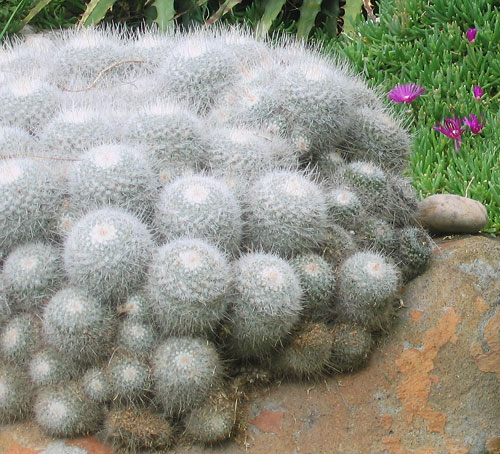 Mammillaria
spinosissima No Common Name Yet Mammillaria
spinosissima No Common Name Yet
Benefits:
From:
Photographed: In the (Ortobotanico) Botanical Garden
in
Naples,
Italy, in 2014.
Planting and Care:
Text and
Photograph © GreenGardeningCookingCuring.com
2014 |
| |
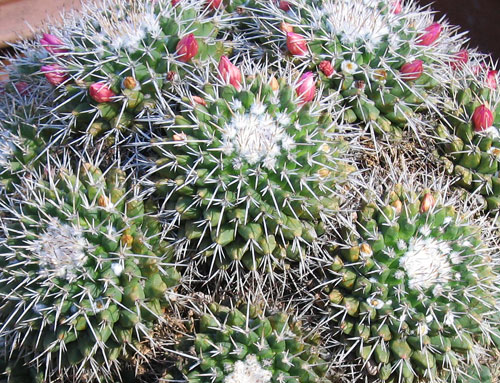 Mexican
Pincushion Mammillaria magnimamamma Mexican
Pincushion Mammillaria magnimamamma
Benefits:
From: Mexico
Photographed: In the Palermo Botanical Garden in Sicily, Italy.
Planting and Care: This 6" tall cactus is not for
a home with a winter though it can take some cold. It is drought tolerant
making it a great choice for a xeriscape garden.
Text and Photograph ©GreenGardeningCookingCuring.com
2012 |
| |
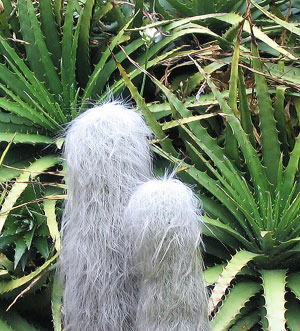 Old
Man Cactus, Old Man of Mexico, Cabeza de Viejo Cephalocereus
senilis Old
Man Cactus, Old Man of Mexico, Cabeza de Viejo Cephalocereus
senilis
This is one of those incredibly appealing cactus and it is lucky to be so because
it is endangered in the wild. Its appeal means it will be maintained in Botanical
and private gardens around the world.
Benefits:
From: Mexico
Photographed: In the Naples, Italy, Botanical Garden
Planting and Care: The Old Man likes full sun with a
bit of shade in the hot afternoons. It will not tolerate temperatures
below 50° F. Even during the summer months it does not require much
water and will live on almost none in the winter. Plant it where it will
have very good drainage. Given these basics, this cactus may grow to
be 45 feet tall with girth of 1 1/2 feet. That is of course if you have
a couple of hundred years to care for it.
Text
and Photograph ©KO 2012 |
| |
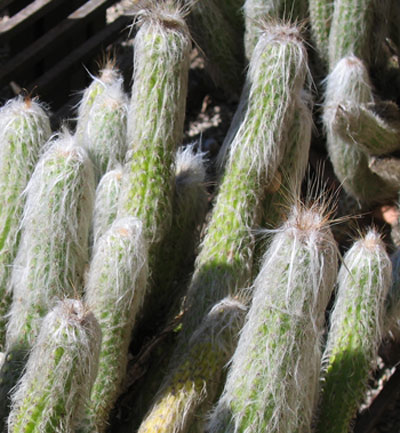 Old
Man of the Andes Morawetzia sericata F. Ritter Old
Man of the Andes Morawetzia sericata F. Ritter
Benefits:
From: Central Peru
Photographed: In the Palermo Botanical Garden in Sicily, Italy.
Planting and Care: This hairy frost tolerant cactus
likes to live in full sun with some afternoon shade in very hot places.
It has beautiful flowers and will grow to be about 4 feet tall. It likes
only light watering.
Text and Photograph ©GreenGardeningCookingCuring.com
2012 |
| |
Peruvian
Old Man Cactus, Cotton Ball Cactus, Snowball Cactus, Snowball
Old Man Espostoa lanata (Kunth) Britton & Rose
Benefits: At one time its wooly hair was used
to stuff pillows
in Peru.
From: Southern Ecuador and Northern Peru
Photographed: All three photographs below were taken in the
Palermo
Botanical
Garden
in
Sicily.
Planting and Care: This is an easy to grow plant that is cold
hardy and will thrive in full sun in fertile well drained soil. Like most cactus
it likes a cool dry winter. It will bloom in late spring and produce edible fruit
if you are lucky.
Text and Photographs ©GreenGardeningCookingCuring.com
2012 |
|
|
| |
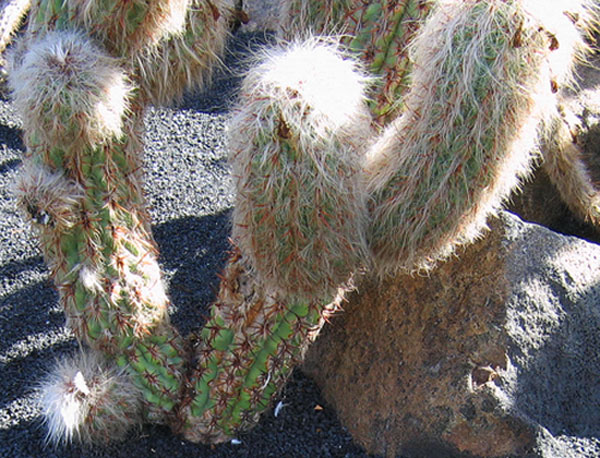 Oreocereus
pseudofossulatus No Common Name Oreocereus
pseudofossulatus No Common Name
Benefits:
From: Bolivia
Photographed: At the Jardin de Cactus
in Lanzarote, Canary Islands, Spain, in 2014.
Planting and Care: This is most definitely a warm climate
cactus liking it no cooler than 50° F, though it can handle temperatures
as low as 20° F for short periods of time. Plant this beauty in full
sun preferably where it will not be in hot afternoon sun.
Text and Photograph ©GreenGardeningCookingCuring.com
2014 |
| |
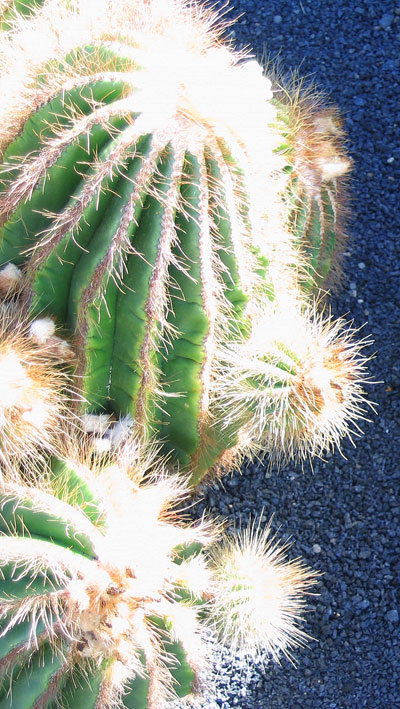 Parodia
magnifica No Common Name Yet Parodia
magnifica No Common Name Yet
When happy the Parodia magnifica will grow to be from three to six inches tall
and 18" wide with pale yellow flowers.
Benefits:
From: Southern Brazil
Photographed: At the Jardin de Cactus
in Lanzarote, Canary Islands, Spain, in 2014.
Planting and Care: This is most definitely a warm climate
cactus liking it no cooler than 50° F.
Text and Photograph ©GreenGardeningCookingCuring.com
2014 |
| |
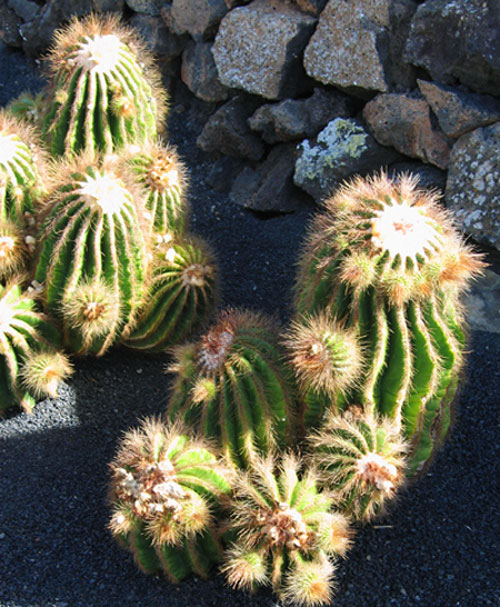 Parodia
warasii No Common Name Yet Parodia
warasii No Common Name Yet
This little beauty produces large yellow flowers when happy and is beautiful
even without blossoms.
Benefits:
From: The southern most parts of South America -- Paraguay, Uruguay,
Brazil and Argentina
Photographed: At the Jardin de
Cactus in Lanzarote, Canary Islands, Spain, in 2014.
Planting and Care: This is another of the warm
climate plants that will not even tolerate weather in Florida.
It likes well drained soil and regular rainfall or watering.
Text and Photograph ©GreenGardeningCookingCuring.com
2014 |
| |
| |
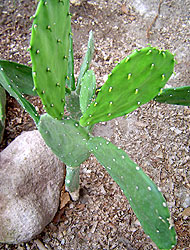 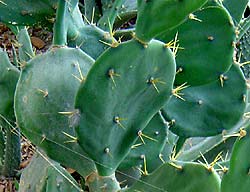 **Prickly Pear Cactus, Indian
Fig Opuntia, Barbury Fig, Cactus Pear, Nopal Cactus, Edible Tree Cactus, Mission Cactus Opuntia
ficus-indica **Prickly Pear Cactus, Indian
Fig Opuntia, Barbury Fig, Cactus Pear, Nopal Cactus, Edible Tree Cactus, Mission Cactus Opuntia
ficus-indica
On
the top left is the oval shaped spiny thin leaved branching
cactus found in Montserrat, but also so common in Mexico.
The leaves are scraped clean of their spines, cooked
and eaten most deliciously in omelets.
The
prickly pear cactus in the photo on the bottom left very closely resembles the
one above, but its paddles are fat and more icy green in color. In Montserrat
they are very subject to a wasting disease that didn't seem to affect our other
cactus plants. The
ice green prickly pear has chubby oval pads with lots of long sharp spines and will
grow to between ten and fifteen feet tall.
Benefits:
In
all of the small outlying villages we have visited in Mexico, the
paddle shaped leaves of the nopal are believed to have a beneficial effect
in controlling diabetes. They may also have a very important effect on cholesterol
-- lowering the bad while leaving the good alone!
The
fruit is said to be helpful in treating coughs. Carefully peel
and wash the pears. Crush the fruit and mix it with honey and
lemon or lime juice. Strain the mixture and take it in tablespoons
as needed.
From: Probably
Mexico
Photographed: On the left and right in
our border gardens at our former home in Montserrat.
Planting
and Care:
Fruits: Its
fruits growing from red and yellow flowers are called tunas in
Mexico; I think the English version is prickly pear. Handle these
fruits carefully as they do have nasty very tiny spines.
Text
and Photographs ©KO 2008 ©GreenGardeningCookingCuring.com
2014
Note: The "opuntia" seems
to be a huge class of paddle shaped cactus plants. They are quite
beautiful and very different from one another in growth, susceptibility
to disease, hardiness and more. Still, I haven't been able to
find good information on specific plants. They always seem lumped
together as opuntia. If you have more information, please get
in touch. |
| |
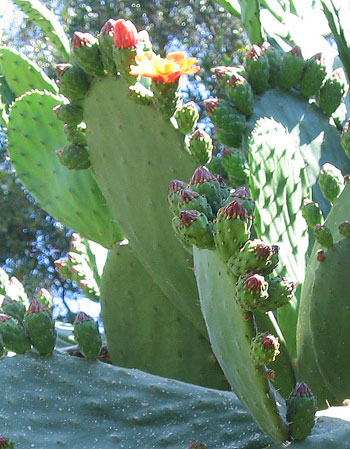 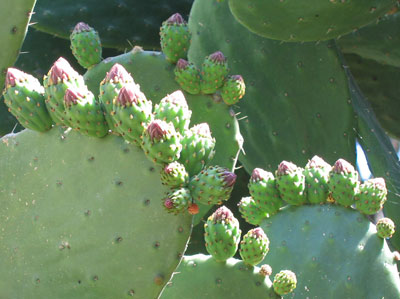 Photographed: In the
Botanical Garden in Palermo, Sicily, Italy, 2012. Photographed: In the
Botanical Garden in Palermo, Sicily, Italy, 2012.
|
| |
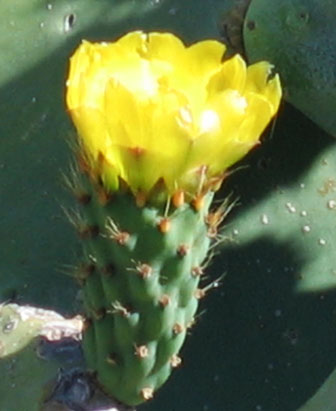 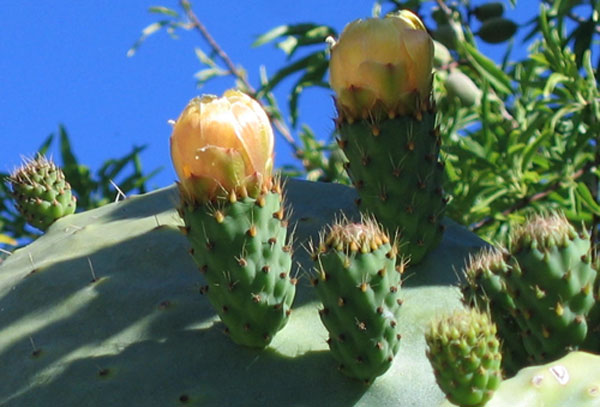 Photographed: On
the roadside in Sicily, Italy, 2012. Photographed: On
the roadside in Sicily, Italy, 2012. |
| |
Photographed: On
the roadside in Sicily, Italy, 2012.
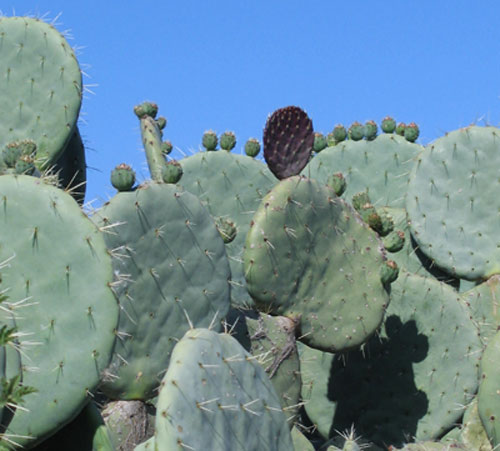 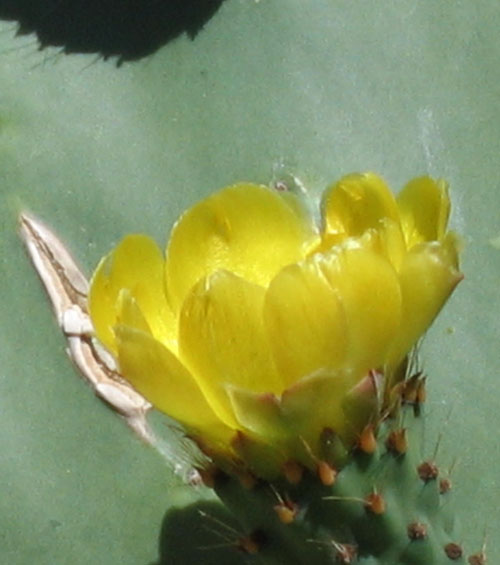 |
| |
Recipe:
Tuna Margarita
Crush
prickly pear fruits and push them through a sieve to remove the
seeds. Add a squeeze of key lime, a few ice cubes and blend with
tequila for a very Mexican margarita. We had this drink for the
first time in Oaxaca, Mexico, at a tequila festival. We liked
it then and we still do! |
| |
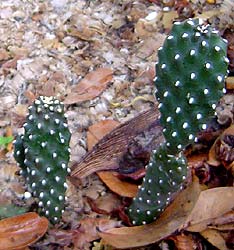 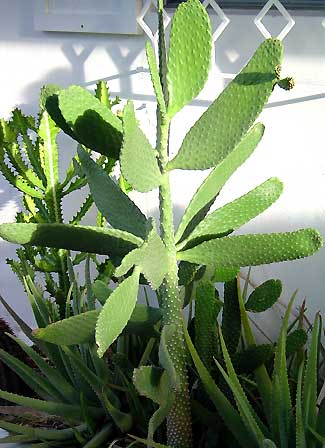 **Road
Kill Cactus, Sour Prickly Pear Cactus Consolea rubescens **Road
Kill Cactus, Sour Prickly Pear Cactus Consolea rubescens
This
cactus has the appearance of having the usual cactus spines,
but it doesn't. One local fellow in Montserrat told us its
leaves were once used to "scrub up." Ours grew to
more than five feet in about as many years. Along the way it
gave us lots of young off shoot plants.
From: The Caribbean
Photographed: Growing in the border
garden at our former home in Montserrat.
Planting and Care: Full sun
and very light occasional rainfall or watering
will keep this fast growing, disease free, spineless
cactus very happy.
Text & Photograph ©KO
2008/2010/2012
|
| |
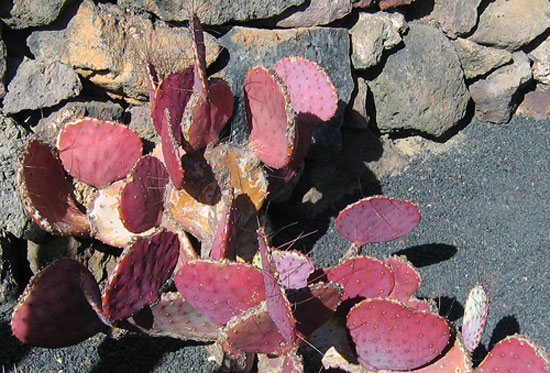 Purple
Prickly Pear, Black-spined Prickly Pear, Long-spine Prickly Pear,
Redeye Prickly Pear Opuntia macrocentra Purple
Prickly Pear, Black-spined Prickly Pear, Long-spine Prickly Pear,
Redeye Prickly Pear Opuntia macrocentra
As you can see in the photograph this is a colorful cactus and it has the added
benefit of large appealing flowers and edible fruit. Who could ask for more?
Benefits:
From: Arizona, New Mexico, Southwestern Texas, Northwestern Mexico and
Baja California
Photographed: At
the Jardin de Cactus in Lanzarote, Canary Islands, Spain, in 2014.
Planting
and Care: Always remember this is a cactus. Keep it in the
sun and keep it relatively dry.
Text and Photograph ©GreenGardeningCookingCuring.com
2014 |
| |
San
Pedro Cactus Echinopsis pachanoi
This fast growing beauty will normally
grow from 10 to twenty feet tall, but it has been seen at
40 feet
which must be spectacular.
Benefits: Oddly
enough the San Pedro Cactus is used not only for medicinal
purposes
in humans,
but also in veterinary applications.
From: South American countries in the Andes Mountains at a mile
high
Photographed: At the Jardin de Cactus
in Lanzarote, Canary Islands, Spain, in 2014.
Planting and Care: The San Pedro adapts to areas with
more rainfall than cactus usually like and it can handle lower temperatures
than many other cactus. Try to plant it in an area that may get some shade
from mid day sun in the hot summer season as the plant may actually become
sun burned.
Text and Photographs ©GreenGardeningCookingCuring.com
2014
My
Cactus/Succulent Mysteries 164A, 164B and 166 were all solved
with the help of a friend on Twitter.
|
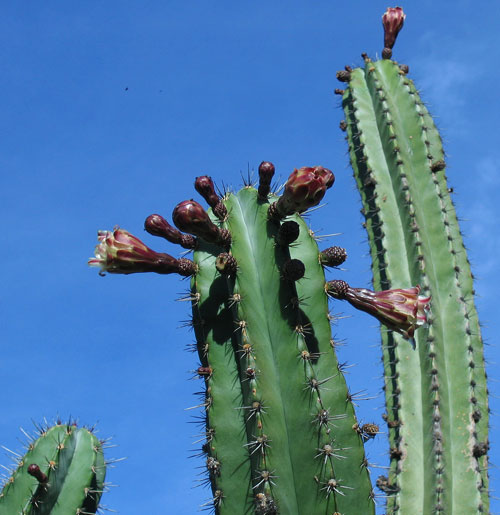
|
| |
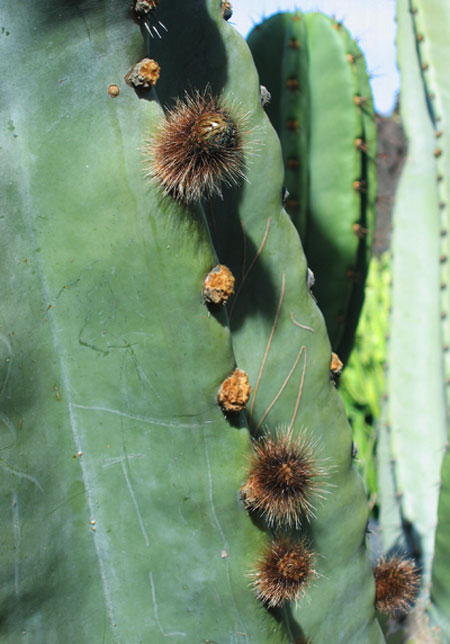 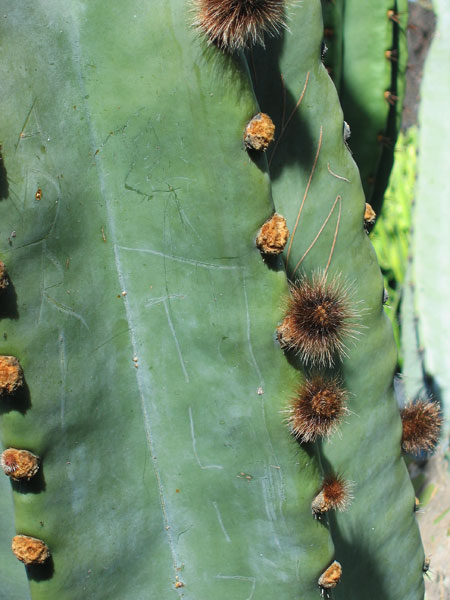 |
| |
Silver
Torch Cactus, Wooly Torch Cactus Cleistocactus
strausii
I've never had one of these beauties in my cactus gardens, but I would jump at
the chance. They are enchanting.
Benefits:
From: High altitude Bolivia and Argentina
Photographed:
Planting and Care: Growing to 9 or 10 feet tall,
the silver torch cactus will tolerate light frost. It prefers to grow in full
sun
except
in hot desert climates where it will prefer a little shade. It likes a sandy
well drained soil to be at its best.
Text and Photographs ©GreenGardeningCookingCuring.com
2014 |
| |
Photographed: In
the Botanical Garden in Naples, Italy, in 2012.
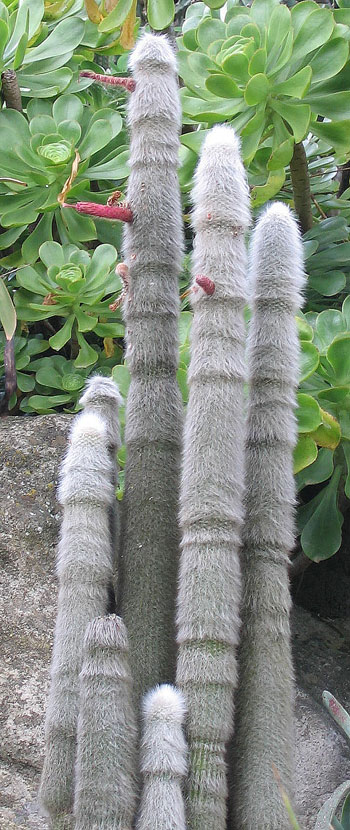
|
Photographed: In
the Palermo Botanical Garden in Sicily, Italy, in 2012.
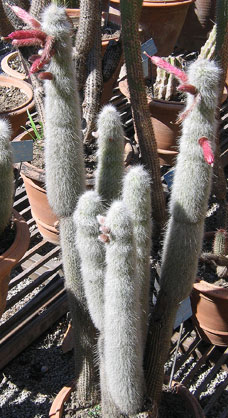
|
Photographed: In
the Royal Botanic Garden in Sydney, Australia, in 2013.
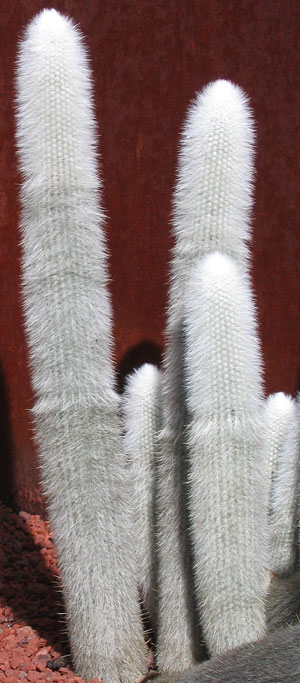
|
|
| |
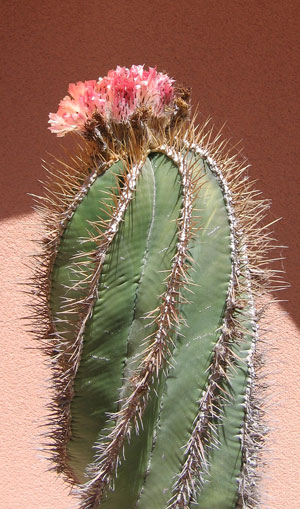 Star
Cactus, Monk's Hood Astrophytum ornatum Star
Cactus, Monk's Hood Astrophytum ornatum
Benefits:
From: Central Mexico
Photographed: In the Palermo Botanical Garden in Sicily, Italy.
Planting and Care: This swirling beauty can be found
growing happily on rocky cliffs where it grows in full sun. It will also
tolerate some bright shade with morning or afternoon sun. For a cactus
it is relatively cold hardy, but it will not do well in a humid climate.
Text and Photograph ©GreenGardeningCookingCuring.com
2012 |
| |
**Stem
Succulent, Starfish Cactus Stapelia lepida or Stapelia
gigantea
When I planted it in our cactus garden, it had a large papery looking flower
bud which opened just a few days later. The flower resembles a starfish in shape.
It is about six or seven inches across and it attracts flies with its unpleasant
scent. The flower almost dwarfs the tube like plant which is only about eight
inches tall.
From: S.
Africa
Planting and Growth: The Stapelia
is another wonderful tough and delightful plant. It lives happily in our 'front
of the house' cactus garden where it receives not much rain or anything else.
Still, it blooms with abandon. The flowers are beautiful and extraordinary, but
they attract flies, though this is not a problem when the plant is not next to
your entryway door. We will be moving the plant soon!
Text & Photograph ©KO 2008 |
| |
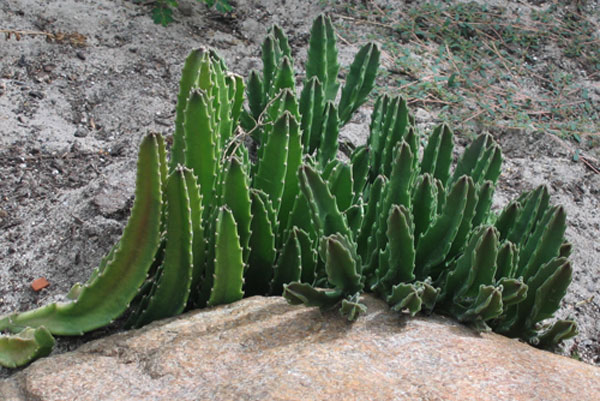 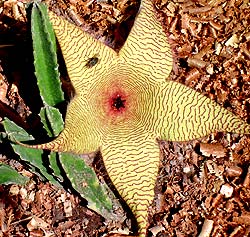 Photographed: To
the left at the Roger Williams Park Botanical Center in Rhode Island
in
2014 and on the right in
our border gardens at our former home in Montserrat. Photographed: To
the left at the Roger Williams Park Botanical Center in Rhode Island
in
2014 and on the right in
our border gardens at our former home in Montserrat.
|
| |
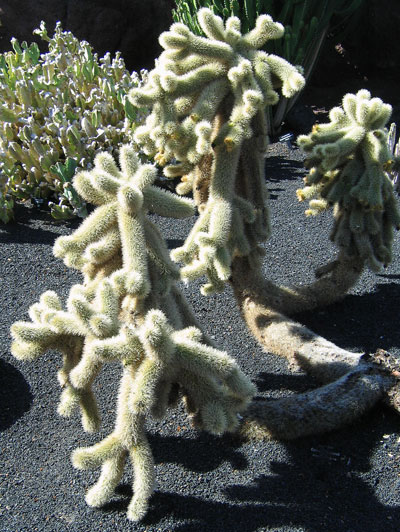 Teddy
Bear Cholla Opuntia bigelovii, syn.
Cylindropuntia bigelovii Teddy
Bear Cholla Opuntia bigelovii, syn.
Cylindropuntia bigelovii
Benefits:
From: Northwestern Mexico and the American southwest
Photographed: At the Jardin de Cactus
in Lanzarote, Canary Islands, Spain, in 2014.
Planting and Care:
Text and Photograph ©GreenGardeningCookingCuring.com
2014 |
| |
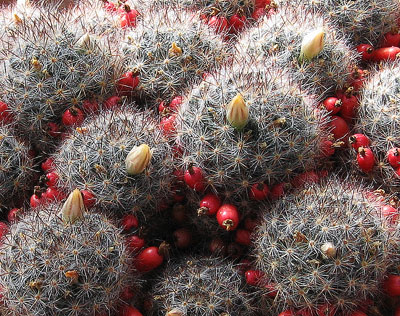 Texas
Nipple Cactus Mammillaria prolifera Texas
Nipple Cactus Mammillaria prolifera
Benefits:
From:
Photographed: In the Palermo Botanical Garden in Sicily, Italy.
Planting and Care: Plant in full sun in sandy well drained
soil and water only infrequently. This cactus normally grows in hot dry
and rocky places so try to duplicate that experience and you'll have great
success.
Text and Photograph ©GreenGardeningCookingCuring.com
2012 |
| |
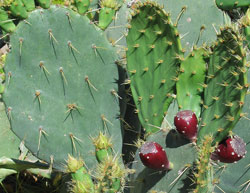 Texas
Prickly Pear Opuntia lindheimer E. Texas
Prickly Pear Opuntia lindheimer E.
This lovely 3 to 6 foot cactus will bare flowers in a range of lovely colors
from yellow to yellow orange to red and they may be seen on the plant all at
the same time.
Benefits: Purple pear shaped "tunas." These
fruits are delicious, but be careful when handling them as there are
tiny spines that can be very irritating to sensitive skin. Somewhere
on this site you'll also find a recipe for tuna flavored margaritas that
we discovered in Oaxaca, Mexico. They are delicious.
From: The United States, probably Texas.
Photographed: In the Palermo Botanical Garden in Sicily,
Italy.
Planting and Care: Plant this cactus in well drained
soil and restrict its water to times that it is completely dry. Luckily
it is cold and heat tolerant.
Text and Photograph ©GreenGardeningCookingCuring.com
2012 |
| |
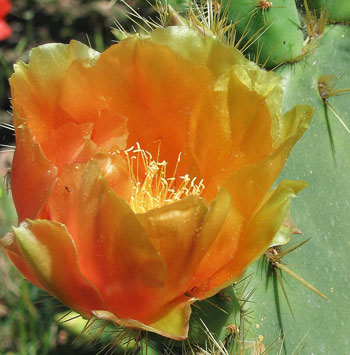 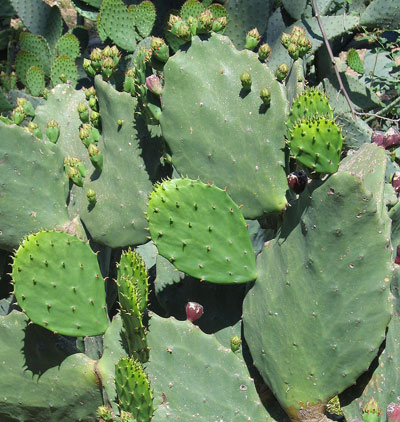 |
| |
|
TURKS CAP CACTUS |
| |
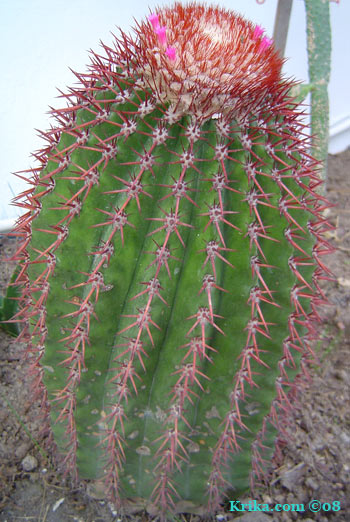 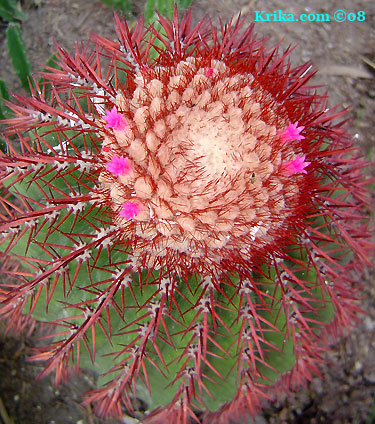 **Turks
Cap Cactus Melocactus
intortus **Turks
Cap Cactus Melocactus
intortus
When young, turks caps closely resemble barrel cactus; when more mature they
become quite distinctive, having a wide cone like form as you can see on your
left. When flowering (after years) they have very tiny fluorescent hot pink flowers
that you'll have to put your glasses on to appreciate as you can see on your
right. What I found extraordinary about this plant is that it produces seeds
that look just like the "cherry bombs" kids love, complete with wick.
Take a look at the photographs below.
From: Tropical America
Photographed: In
the front border gardens at our former home in Montserrat.
Text and Photographs ©Krika.com
2008/2009 |
| |
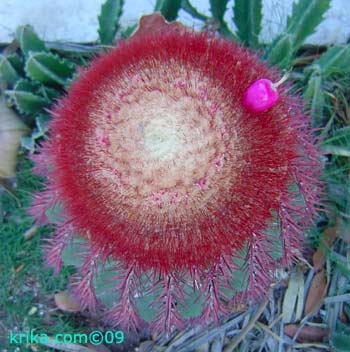 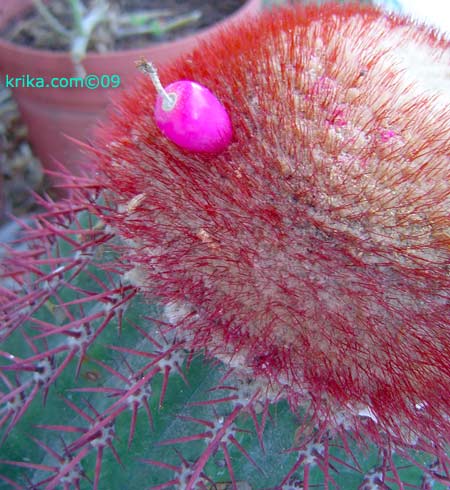 Seeds
of this interesting cactus look surprisingly like small firecrackers. Seeds
of this interesting cactus look surprisingly like small firecrackers. |
| |
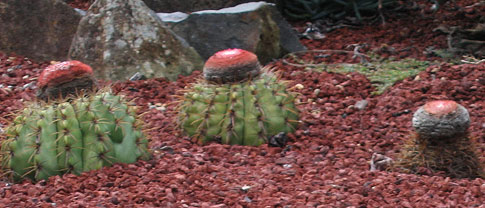 Turks
Cap Cactus (2) Turks
Cap Cactus (2)
Benefits:
From:
Photographed: In the Royal Botanical Gardens in Sydney,
Australia, 2013.
Planting and Care:
Text and Photograph ©GreenGardeningCookingCuring.com
2013 |
| |
|
| |